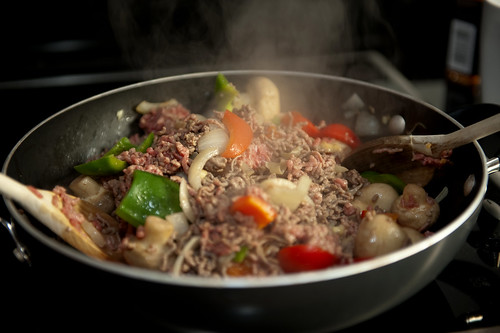This is the 3rd post in December’s Top Tens in 2010 Series. This guest post was written by Rory Ellis, an internet marketer who has been known to play with fire.
As you find yourself making the transition from living off of fast food and ramen noodles in college, it becomes apparent that some expertise in the kitchen will help ward off the weight gain, and the strain on your wallet that restaurant food can cause. I often hear the phrase “I can’t cook” and simply shake my head in disagreement. Cooking is not hard, it’s just a matter of learning how.  When you break it down and take a look at a few recipes, you will see that the majority of the meals that you find are created using only a handful of techniques that are easy to master with a little practice. I’ve come up with the top ten cooking techniques that I’ve found will allow you to make just about any meal you can dream up, and on occasion impress those who see cooking as a challenge reserved for short-order chefs.
When you break it down and take a look at a few recipes, you will see that the majority of the meals that you find are created using only a handful of techniques that are easy to master with a little practice. I’ve come up with the top ten cooking techniques that I’ve found will allow you to make just about any meal you can dream up, and on occasion impress those who see cooking as a challenge reserved for short-order chefs.
- Standard Kitchen Cutting Techniques: A chef’s knife is one of your most versatile tools in the kitchen. Slicing, chopping, dicing, and mincing are a few of the cuts that you should learn to make when preparing a meal. A quick search online will provide the necessary specifications for each, but in reality, they are in essence increasingly smaller increments of cutting your ingredients into the consistency that you need for the dish you’ve chosen. Cutting & Chopping. Got it.
- Browning: Many individuals start their cooking journey by using the “Just add meat” meal in a box solutions. These are quick, easily prepared with a single skillet and require minimal effort on your part. The main technique to master when cooking these dishes is called browning. When preparing this dish, you must begin to cook the meat before the other ingredients to ensure that the finished product is fully cooked; however, it’s important not to overcook the meat to avoid a tough or dry final product. Browning is simply partially cooking a meat while stirring (typically ground beef or ground turkey) until there is no pink left on the outside, but it is not fully cooked on the inside. After draining the fat from the meat, it will finish cooking with the other ingredients to produce a savory meal.
- Frying: Whether it is deep vat or pan frying, the idea is the same. Frying uses hot oil to cook your ingredients. This technique generally produces a much juicier meal (albeit not quite as healthy) than some other cooking techniques. It even allows you to coat your meat or veggies in some other ingredient (think fried chicken) to give it the crispy on the outside, juicy on the inside experience.
- Roasting: Similar to baking (see #10 below if you are impatient), Roasting involves cooking with a dry heat, often in an oven. This technique is usually used for larger pieces of meat such as the traditional thanksgiving turkey. Since you use a dry heat, it is often a good idea to baste your meat with it’s own juices and other flavoring ingredients to ensure that it doesn’t get too dry.
- Saute: By mixing ingredients in a pan with a little oil at a high heat, you can create many sizzling concoctions and flavors. This type of cooking allows you to caramelize ingredients like onions with a meat of your choice to maintain a tender texture and infuse flavors together. It is a common practice to use what is left of the drippings as a sauce for the dish.
- Stir Frying: Stir frying is a technique similar to sauteing that brings together many ingredients into a dish that is cooked at high heat with constant stirring (usually faster than a sauté) in a wok. It is commonly seen in Asian dishes but the idea can be used to make any variety of quick and easy dishes. This is one of my favorite techniques to experiment with for new flavors. Bite sized chunks of meat make this an easy meal to eat whether using a fork or chopsticks; and fresh veggies are almost always a necessity with this technique, so stay away from anything in a can that could come out squishy after cooking.
- Grilling: The long time favorite of Sunday afternoon cookouts and tailgaters alike, grilling involves cooking directly over hot coals or a gas flame (coal is my favorite btw). This is usually reserved mainly for meats, but grilling also gives vegetables like corn or potatoes a wonderful smoky flavor that is sure to please everyone.
- Slow Cooking: There are a lot of ways to cook slowly (in some cases a hot summer’s day in Texas could work), but a crock pot or similar device is far more efficient. This technique works well to produce a delicious meal that is ready when you get home from work. Often used for stews, roast beef, or poultry, by placing your ingredients in a slow cooker you allow the meal to soak in it’s own juices while it is slowly cooking all day long to produce an incredibly tender and flavorful dish.
- Poaching: When working with a delicate food, or when attempting to create a healthy dish without the use of oil, you can actually cook with another liquid. Water provides a great cooking method for many ingredients that you wish to remain juicy, or if it is something delicate, remain intact. My favorite use of this method is the poached egg. One of the finest breakfast dishes around is Eggs Benedict which cannot be produced without learning to poach an egg to the perfect consistency.
- Baking: At some point in your life you will probably know someone who has a birthday (or if you have no friends, you can substitute your own). On this wonderful occasion, cake is customary. I however, personally hate most cakes that people pick up at the grocery store bakery for birthday parties. I’m a pie fan myself, but there is a wide variety of amazing baked goods that are sure to wow everyone when presented at your next gathering. I will admit that I like to cheat and buy the boxed cake mixes, but even if you want to try your hand at making something from scratch, baking simply requires that you mix together a few ingredients and stick them in the oven at the predetermined temperature and set a timer so you don’t forget about it. (I cannot stress the timer part enough! The biggest problem I have found with baking is getting sidetracked and forgetting about it until it’s too late). After that, you can get creative with icing or other garnishments to make your creation pretty to look at and add some flare!
Now go experiment with what’s in your fridge and try not to burn the house down! Share your favorite cooking technique/recipe/or recipe resource in the comments.


Wao ! This is really informative!
You’re most welcome to use my picture of the food being cooked, but I do require attribution. Please add Photo Bob Peters, Photo BobPetUK or something similar as a byline. Many Thanks,
Bob Peters
Bob Peters Photography (UK)
BobPetUK@yahoo.com